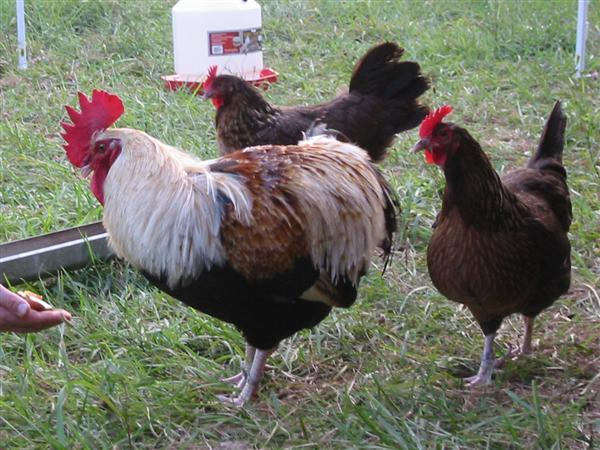here's a pic of one off the Dorking Breeder's club website...

I'm trying to figure out what genetics are involved with this, and how I would go about getting one that breeds true each time.
right now nearly all the "colored" dorkings available don't breed true apparently, and there is a lot of variation within the lines.
the other colors Dorkings are available in are red (mahogany bbr i believe) and silver grey (silver duckwing). I'm willing to try crossing between these colors and spending generations on this to see what comes out of it all.
I don't know much about the various colors in other breeds, but reading around it seems like maybe it's a dilute? but with something else combined maybe? I'm thinking because of the variable results the dilutes may have been bred with the reds, so you've got the mahogany being combined with dilute now and then, resulting in basically something along the lines of a BBR (faded mahogany?) I don't know the right terminology used in poultry, but it would be akin to the silvers in poodles. homozygous is a true silver, heterozygous results in a blue, and no silver gene at all is a black... I've always just referred to it as a 'fading' gene, since it lightens whatever base color was there originally. (combine silver and brown in poodles, you get cafe au lait and silver beige - single and double factor respectively). similar also to buckskin/palomino in horses (depending on bay or chestnut lines) a single factor lightening the color by 1 step, and double lightening even further (cremello).
so someone help me out here? help me figure out where to start and what to plan for? I'm waiting on chicks (colored and red) from sandhill preservation center, and already have silver greys. my ultimate goal here is to have true breeding birds of all 3 colors, and to improve on size and conformation of all 3 varieties, but if that involves crossing colors to get a "colored" line to eventually breed true, i'm all for it. the reds and silver greys already breed true, but have their own issues in other respects.

I'm trying to figure out what genetics are involved with this, and how I would go about getting one that breeds true each time.
right now nearly all the "colored" dorkings available don't breed true apparently, and there is a lot of variation within the lines.
the other colors Dorkings are available in are red (mahogany bbr i believe) and silver grey (silver duckwing). I'm willing to try crossing between these colors and spending generations on this to see what comes out of it all.
I don't know much about the various colors in other breeds, but reading around it seems like maybe it's a dilute? but with something else combined maybe? I'm thinking because of the variable results the dilutes may have been bred with the reds, so you've got the mahogany being combined with dilute now and then, resulting in basically something along the lines of a BBR (faded mahogany?) I don't know the right terminology used in poultry, but it would be akin to the silvers in poodles. homozygous is a true silver, heterozygous results in a blue, and no silver gene at all is a black... I've always just referred to it as a 'fading' gene, since it lightens whatever base color was there originally. (combine silver and brown in poodles, you get cafe au lait and silver beige - single and double factor respectively). similar also to buckskin/palomino in horses (depending on bay or chestnut lines) a single factor lightening the color by 1 step, and double lightening even further (cremello).
so someone help me out here? help me figure out where to start and what to plan for? I'm waiting on chicks (colored and red) from sandhill preservation center, and already have silver greys. my ultimate goal here is to have true breeding birds of all 3 colors, and to improve on size and conformation of all 3 varieties, but if that involves crossing colors to get a "colored" line to eventually breed true, i'm all for it. the reds and silver greys already breed true, but have their own issues in other respects.




